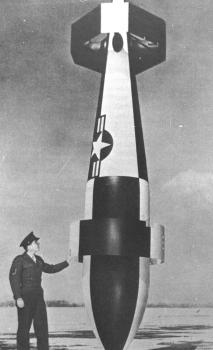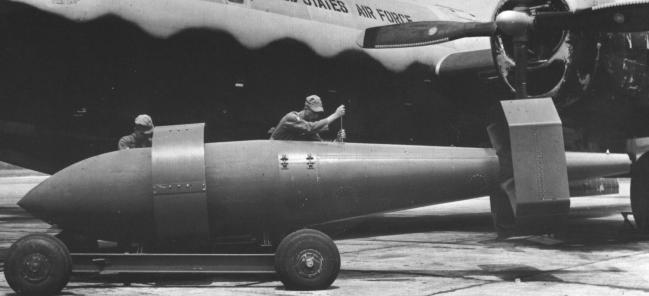Bell ASM-A-1 Tarzon (original) (raw)
In February 1945 the U.S. Army Air Force began a development program for a very large guided bomb designated VB-13 Tarzon. The VB-13, built by Bell Aircraft, was the combination of the command guidance system of the earlierVB-3/VB-4 Razon bombs with the British 5400 kg (12000 lb) Tallboy free-fall bomb. After the end of World War II, the project continued with low priority. In 1948, the Tarzon was redesignated as ASM-A-1 guided missile, and the test models became the YASM-A-1.
 |
|---|
| Photo: USAF |
| YASM-A-1 |
The VB-13/ASM-A-1 was an unpowered free-fall bomb fitted with a circular lift shroud and a tail-mounted octagonal control shroud. Because of its size, it could be carried only semi-recessed in the bomb bay of the B-29 Superfortress. When the bomb was dropped, a bright flare in the its tail was ignited, which was then visually tracked by the bombardier. When the VB-13 deviated from the planned course, he would use a control stick to send corrective commands to the weapon, which had movable flying surfaces on its tail shroud. The guidance system consisted of the AN/ARW-38 radio transmitter in the B-29 and an AN/URW-2 receiver in the missile.
 |
|---|
| Photo: USAF |
| ASM-A-1 |
Beginning in December 1950, the ASM-A-1 was used in the Korean War for attacks on selected strategic bridges, which were hard to hit, let alone destroy, with conventional unguided bombs. There were several problems with the Tarzons, but the weapon was eventually credited with six destroyed targets in Korea. However, in mid-1951 the Tarzon was withdrawn from service, mainly because the continuing technical problems (including safety problems which had caused the loss of one aircraft with all crew) and the huge maintenance, training and procedures overhead necessary with this "non-standard" bomb.
Specifications
Note: Data given by several sources show slight variations. Figures given below may therefore be inaccurate!
Data for ASM-A-1:
| Length | 6.40 m (21 ft) |
|---|---|
| Diameter (body) | 0.97 m (3 ft 2 in) |
| Diameter (lift shroud) | 1.37 m (4 ft 6 in) |
| Weight | 5400 kg (12000 lb) |
| Propulsion | none |
| Warhead | High explosive |
Main Sources
[1] Frederick I. Ordway III, Ronald C. Wakeford: "International Missile and Spacecraft Guide", McGraw-Hill, 1960
[2] Bill Gunston: "The Illustrated Encyclopedia of Rockets and Missiles", Salamander Books Ltd, 1979
[3] A.J. Pelletier: "Beech Aircraft and their Predecessors", Putnam, 1995
Back to Directory of U.S. Military Rockets and Missiles, Appendix 1
Last Updated: 4 January 2003